As an IT manager, you know how important integration platforms are in streamlining your IT operations and maximizing efficiency. MuleSoft has long been a prominent player in the integration landscape, capable of automating your organization's various workflows. However, you need to consider MuleSoft alternatives to ensure you get a suitable solution for your organization.
MuleSoft Anypoint Platform provides an automation capability that enables your IT team to streamline workflows like employee onboarding and offboarding. It empowers your organization's IT environment to connect seamlessly with various systems, applications, and data sources.
By leveraging the MuleSoft Anypoint platform's intuitive visual interface, your IT team can automate repetitive tasks (user provisioning and de-provisioning), reducing the manual effort of granting or revoking access and minimizing the risk of human errors.
However, it has a few drawbacks that create challenges in managing your IT processes efficiently. For this reason, it's crucial to consider various MuleSoft alternatives that will meet your organization's requirements. But before discussing the alternatives to MuleSoft, let's know more about it.
Key Features of MuleSoft Anypoint Platform
Below is a wide range of essential features of the MuleSoft Anypoint Platform.
- Connectivity Simplified: Its ability to simplify connectivity is at the heart of the MuleSoft Anypoint Platform. Anypoint Platform provides a unified integration framework, allowing for effortless connection and communication between various endpoints. This means quicker access to critical data, reduced silos, and a more agile business environment.
- Effortless API Management: Anypoint Platform offers a comprehensive API management solution, enabling businesses to create, manage, and govern APIs effortlessly. This seamless API management empowers organizations to adapt swiftly to changing business needs.
- Accelerated Development with Anypoint Studio: Anypoint Studio, the integrated development environment (IDE) of MuleSoft, is a game-changer for IT managers overseeing development teams. This accelerates the development lifecycle, enabling teams to deliver high-quality integrations at a faster pace.
- Real-time Monitoring and Analytics: Anypoint Platform provides real-time monitoring and analytics, offering valuable insights into the performance of integrations. Track key metrics, identify bottlenecks, and proactively address issues before they impact operations. This proactive approach to monitoring ensures a resilient and responsive IT infrastructure.
Drawbacks of MuleSoft Anypoint Platform
Here are a few drawbacks of the MuleSoft Anypoint Platform.
- If you are limited with your financial resources, then this may not be an affordable option to automate your IT processes, as it is more expensive than other tools
- The tool can restrict the capabilities of integrating with multiple systems, especially integrating with cloud-based systems, resulting in inefficiency for your IT team to automate IT processes efficiently
- The tool offers your team a complicated UI, making it inconvenient for them to automate their routine tasks and IT processes efficiently
Customer rating
- G2: 4.4/5
In this article, we delve into the world of MuleSoft alternatives, highlighting their key features, benefits, pros, and cons to help you make an informed decision.
9 Alternatives to MuleSoft’s Anypoint Platform
Let us explore the various Mulesoft alternatives.
1. Zluri
Zluri offers your IT team an intelligent user lifecycle management platform that helps them automate various IT processes in your organization. By streamlining these processes, Zluri helps to eliminate tedious and time-consuming tasks, such as employee onboarding and offboarding.
Zluri integrates with your HRMS platforms, such as Workday or BambooHR. When a new employee joins or leaves your company, Zluri automatically updates the dashboard that can be accessed by your IT teams, who can use the information to grant or remove access for employees.
But let’s see how Zluri does this. Here's how Zluri simplifies the process:
- Automating onboarding workflow
You create an onboarding workflow by clicking on \"new workflow.\"

Select the users, and you can choose multiple users if needed.

Based on the employee's role, designation, and position, you can use the \"recommendation app\" to select the applications they need access to. Let's say you choose Slack.

Within the app, you'll receive \"in-app suggestions\" that provide actions to take, such as sending invites to specific channels.
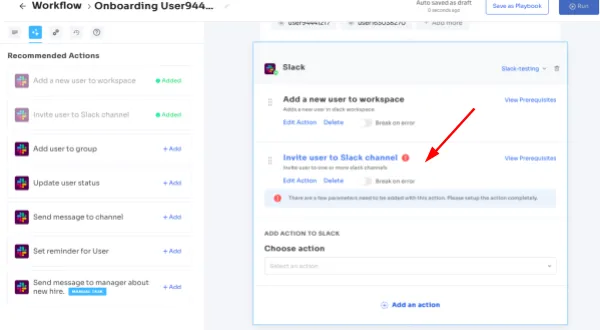
You can customize these actions and add any necessary details. You also have the option to schedule these actions to run on the employee's onboarding day.
Now, all your team has to do is click on \"run\" or save it in the \"playbook\" for future use. To keep track of the workflow's progress, you can check the status in the \"recent run\" tab.

Your IT admin can also set triggers, conditions, and actions in the \"automation rule\" tab. This will automatically grant new hires access to Slack based on your defined triggers.

But Zluri goes even further to improve employee experience and eliminate manual ticketing systems. Let’s see how.
- Automating approval workflow
Zluri provides a self-service platform called the \"Employee App Store.\" It's a collection of pre-approved and verified SaaS applications handpicked by your IT admin. This gives your employees the freedom to choose any app from the store and quickly gain access to it.
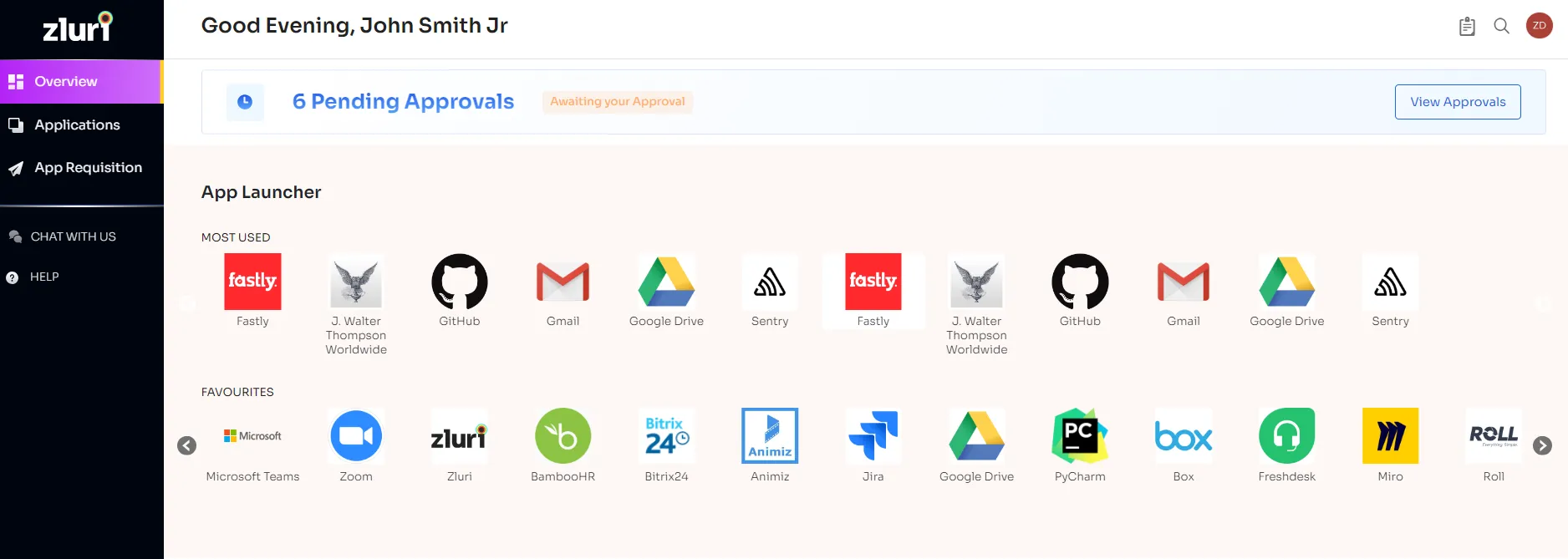
To request access to an application through the EAS, your employees can follow these simple steps:
On the Zluri main interface, look for an icon in the upper right corner and click on it. A drop-down menu will appear. Select 'Switch to Employee View' from the menu to access the Employee View.

By default, the Overview dashboard will appear. Click on 'Request Access to an Application.'

A dialogue box will appear where your employees can enter the application name they need access to. Click on 'Continue.'

In some cases, certain applications may not be used in the organization. However, your employees can still request them. Click on 'Continue,' and another dialogue box will show similar applications used in the organization.
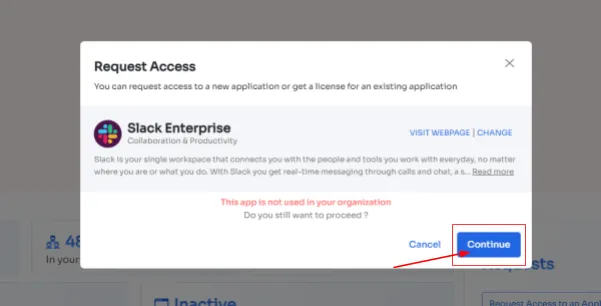
If your employees want to choose a similar application, they can simply click on it. Alternatively, they can click on 'Ignore and Continue' to proceed with their request.
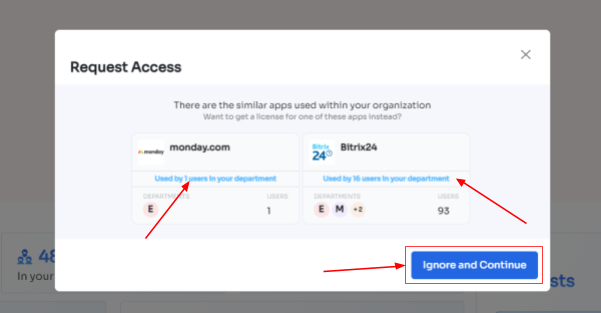
Next, they need to provide the required details, such as selecting the license plan and subscription duration and describing why they need the application. They can also attach supporting documents if necessary. Once everything is filled out, click on 'Confirm Request.'

If there are any modifications to the request or if one of the approvers suggests alternative applications, your employee can check the 'Changelogs' for updates.”

- Automating offboarding workflow
Your team can also create an offboarding process in a similar way. Start by going to Zluri's main interface and selecting the workflow module. From there, choose \"offboarding\" from the drop-down menu and click on \"New Workflow.\"
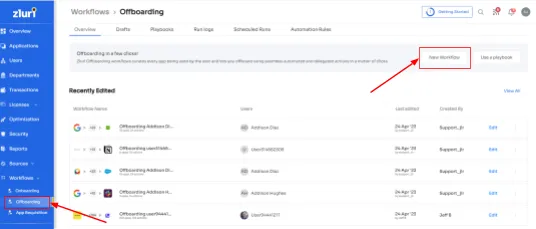
Inside the platform, you'll find a specific box for offboarding users. You can locate the employees you want to offboard by scrolling through the list or using the search bar. After selecting the users, click \"Continue.\"
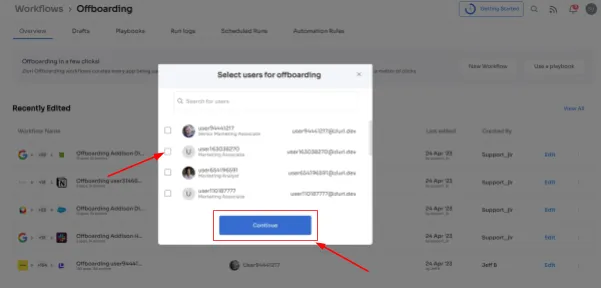
Next, you can review all the applications accessible to the offboarded employees. When you click on an application, you'll see suggested actions under \"recommended actions.\" You can choose and perform the necessary actions for each selected application.

Lastly, don't forget to save the workflow as a \"playbook\" for future use. This way, you can easily refer to it whenever you need it.
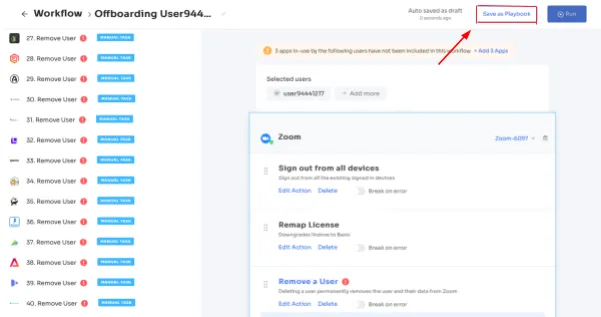
Request a demo today!
Pros
- Zluri offers over 300 API integrations, and you can easily add your own custom integrations to your system within just 36 hours.
- The platform allows you to set up conditional triggers that automate complicated IT processes. This saves your IT teams valuable time and effort by eliminating manual tasks that can lead to errors.
- Also, it can help your team improve their overall efficiency while also reducing costs and increasing revenue
- Moreover, it provides a centralized location for all the business data, giving your IT teams better visibility on the company's performance and allowing them to make data-driven decisions
Cons
- Streamlining Zluri with your current systems and workflows might necessitate extra time and resources, particularly for enterprises managing complicated IT environments.
Customer Rating
- G2: 4.8/5
- Capterra: 4.9/5
2. Workato

Workato, one of the notified MuleSoft alternatives, offers an automation platform and integration solution that empowers your IT team to optimize operations, increase productivity, and drive digital transformation. With its intuitive workflow automation, seamless application integration, automated incident management, proactive alerts, and effortless data migration and synchronization.
From ticketing systems and monitoring tools to cloud services and databases, Workato seamlessly integrates with a wide range of applications. This ensures smooth information flow across your IT ecosystem. By leveraging Workato, you can focus on strategic initiatives, enhance service delivery, and achieve operational excellence.
Pros
- While comparing MuleSoft vs Workato, the tool offers your team an intuitive and excellent UI, making it convenient for them to use the automation capabilities at their full potential
- The tool offers flexibility to integrate with any software or platform available in the market, making it easy for your IT team to automate the IT processes efficiently
Cons
- If you are looking for an affordable solution, then this may not be a suitable option, as its pricing model is based on the number of automation. As a result, if your team wants to automate a simple task that is not very frequent, an additional amount is charged
- The tool has limitations in the document size that your team requires to import, leading to investing additional time to reduce the file size and then import for automating the tasks at their full potential
Customer rating
- G2: 4.7/5
Also Read: If you want to compare with Mulesoft in detail, you can go through Workato vs Mulesoft
3. Zapier

Zapier, a prominent alternative to MuleSoft, provides a workflow automation solution for both large and small IT teams. It automates your teams' repetitive tasks, integrates with your organization's existing systems, and offers customization options.
Zapier empowers your IT team to focus on strategic initiatives and deliver exceptional service to the organization. With real-time monitoring and reporting, Zapier ensures continuous improvement and helps you make data-driven decisions.
Pros
- When comparing MuleSoft vs. Zapier, Zapier gives your IT team the flexibility to manually add the tools that are not available in the library, enabling them to automate the IT processes efficiently
- The tool provides some extensive features like triggers, which help your IT teams to integrate with multiple systems seamlessly
Cons
- The tool's user interface is slow, making it difficult for your team to streamline the IT processes, and ends up consuming a lot of time that they could have used in some important tasks
- Though, Zapier does offer a free plan, but with just a few simple integrations. Therefore, if you need a tool with advanced integration capabilities, you must choose the paid plan, which is slightly costlier. Thus, if you are tight on your budget, you must look for an alternative, as it may not be a suitable option.
Customer rating
- G2: 4.5/5
- Capterra: 4.7/5
4. Make

Make, one of the best Mulesoft alternatives, the ultimate IT process automation tool for enhancing efficiency, productivity, and collaboration. By automating routine tasks, integrating with existing infrastructure, and offering powerful workflow automation, Make empowers your team to streamline processes and achieve remarkable results.
With enhanced visibility, reporting capabilities, and robust security features, the solution ensures your IT team can optimize operations and drive innovation.
Pros
- The tool empowers your team to automate the IT processes seamlessly, as it can collect and process data from multiple sources due to its robust cloud integration capabilities
- The tool is user-friendly, making it easy for your team to learn, integrate, and automate the IT processes efficiently
Cons
- If you are thinking of making a transition from one tool to another process automation tool, then this may not be a suitable option as it is complex to set up, and your team would have to do the entire process from scratch, which consumes a lot of time and effort
- Sometimes, your team needs to invest additional time and effort in connecting APIs with new software in your organization. This can lead to a time-consuming process and delay in automating the process
Customer rating
- G2: 4.7/5
- Capterra: 4.8/5
5. Boomi
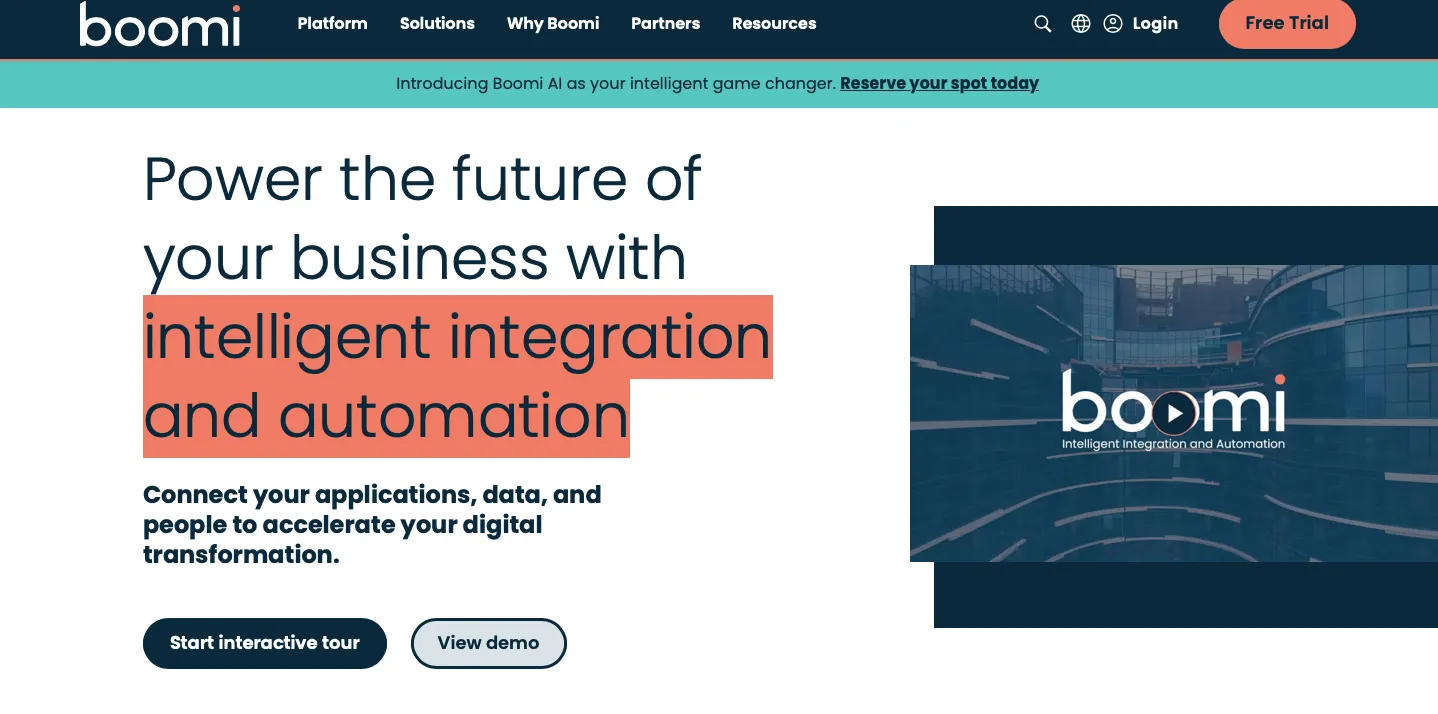
Boomi, one of the prominent MuleSoft alternatives, is an iPaaS solution that connects your organization’s applications, data, and resources to streamline IT processes. This integration software empowers you with robust automation capabilities that simplify data integration, streamline workflows, enhance application deployment, and provide centralized monitoring and management.
By leveraging Boomi's intuitive interface and powerful features, your team can optimize its IT processes, save time and resources, and focus on strategic initiatives.
Pros
- If you're limited with your budget, then this is an affordable solution, as the pricing plans are cost-effective and include app integrations and other features. When comparing MuleSoft vs Boomi, this is a budget-friendly integration solution
Cons
- If you’re looking for an easy-to-use platform for your team, then this is not a suitable solution as it offers quite complex features, which can be a bit overwhelming for them to understand
- If your team wants to filter any data, then this tool restricts them from doing so and asks for more information to filter the required data. As a result, your team gets delayed in managing their tasks effectively.
Customer rating
- G2: 4.3/5
- Capterra: 4.4/5
Also Read: If you want to compare this with Mulesoft in detail, you can read Boomi vs MuleSoft
6. Tray.io

Tray.io, one of the notified MuleSoft alternatives, is an IT process automation tool that seeks to optimize workflows and improve operational efficiency. With its continuous integration, automation capabilities, and centralized monitoring, Tray.io empowers your IT teams to streamline their IT processes and focus on other important tasks.
Moreover, Tray.io's workflow automation capabilities enable you to define triggers, conditions, and actions, allowing for conditional logic and decision-making within your organization’s workflows.
Pros
- If a tool with advanced workflow capability is what your team needs, this is a perfect fit. It will help them create a workflow as per the requirement
Cons
- Sometimes, your team needs to share the workflows with a specific team, but this tool doesn’t allow them to do so as it offers only personal and organizational workflows. As a result, your IT teams lack in creating a departmental workflow
- It has a steep learning curve, requiring you and your team to invest more time to learn and use the workflows at their full potential
Customer rating
- G2: 4.6/5
- Capterra: 4.9/5
7. Kissflow

Kissflow, one of the best MuleSoft competitors, is a powerful IT process automation tool that empowers your team to streamline IT operations, enhance efficiency, and drive innovation within your organization. Automating workflows, simplifying task management, and providing valuable insights enable your team to focus on essential tasks and improve productivity.
Kissflow integrates effortlessly with various third-party tools, including CRM systems, project management platforms, and communication tools. This gives you a centralized view of operations and improves team collaboration. With real-time notifications and activity tracking, you can stay informed and aligned.
Pros
- Kissflow's unified platform makes it easier for your IT team to generate reports for every workflow they create. This helps them view and analyze the workflows and manage them efficiently
- If you are limited on financial resources, then this can be an affordable option for workflow management
Cons
- If you are looking for an optimum and customizable automation tool, then this may not be the option as it has limitations in offering customization options, leading to inefficiencies in automating the organization’s workflows
Customer rating
- G2: 4.3/5
- Capterra: 3.9/5
8. Celigo

Celigo, one of the notified MuleSoft competitor, helps to automate IT processes and enhance operational efficiency. This single platform simplifies this process by providing pre-built connectors and a user-friendly interface, allowing your team to seamlessly connect various systems, such as CRM, ERP, e-commerce platforms, and more.
Whether it's managing approvals, triggering notifications, or initiating data transfers, Celigo empowers you to build custom workflows tailored to your organization's unique requirements. This streamlined workflow automation reduces errors, enhances collaboration, and ensures efficient team execution.
Pros
- The Celigo integration platform provides your team with an easy-to-use interface, making it convenient for them to integrate with multiple tools efficiently
Cons
- The tool's cost structure can become a bit complex as you add new apps requiring additional endpoints to integrate. This adds up the overall cost, which might not your budget for the same
- This tool's error messages are too generic and technical, making it difficult for your team to understand. This further demands additional time and resources to comprehend the error
Customer rating
- G2: 4.6/5
- Capterra: 4.7/5
9. Apigee

Apigee, one of the prominent MuleSoft alternatives, stands out as a powerhouse for your team looking for unparalleled integration and automation capabilities. Designed with simplicity and efficiency, Apigee empowers you to streamline processes, enhance connectivity, and propel digital transformation forward.
At the core of Apigee's prowess lies its robust API management system. This cloud-based integration platform translates to a more cohesive and interconnected IT infrastructure, reducing the challenges associated with disparate systems and ensuring a smooth data flow across the organization.
Apigee eliminates the hassle of integrating diverse applications/ cloud applications and legacy systems within your enterprise. The user-friendly interface ensures that integration processes are efficient and accessible to users with varying technical backgrounds.
Moreover, whether it's automating data transfers, managing workflows, or orchestrating complex business processes, Apigee provides a comprehensive suite of automation features that align with the unique needs of IT managers.
Pros
- Apigee presents an intuitive and user-friendly interface, streamlining the user experience for your team. The platform's design prioritizes simplicity, making it easy for your IT team to navigate and execute tasks efficiently.
- The platform's user-centric design extends to policy applications, making it straightforward for your IT team to set up and modify policies as needed. This all-in-one solution provides ease of policy application and empowers you to maintain a secure and compliant API environment without unnecessary complexities.
Cons
- One challenge faced by Apigee is the misalignment of its user interface with popular offline development tools like the Visual Studio Code. This disconnect can create a less cohesive workflow, requiring your team to switch between environments, which may hinder efficiency.
- While comparing MuleSoft vs Apigee, another potential drawback of Apigee lies in the manual efforts required for tasks such as exporting and importing and the creation of new versions of proxies. Your team may find this process time-consuming and prone to errors.
Customer Rating
- G2: 4.4/5
- Capterra: 4.6/5
FAQs
What is the alternative to MuleSoft?
When it comes to seamlessly migrating data into a data warehouse, Informatica stands out as the superior choice compared to MuleSoft. Informatica's unparalleled expertise in data hubs and specialized data integration ensures a smooth and efficient transition for your data.
In the realm of B2B integrations demanding EDI-based file transfers, Boomi and Jitterbit emerge as the top contenders. These hybrid integration platforms handle intricate B2B integration scenarios, providing robust solutions for seamless and secure EDI-based file transfers.
Why is MuleSoft so expensive?
Mastering the MuleSoft Anypoint platform requires a dedicated investment in training and hands-on experience. The platform's rich array of features and capabilities is a testament to its power, but it also means that business users benefit greatly from extensive training and expertise to harness its full potential.
It's important to note that the robust feature set of MuleSoft comes at a certain cost. While the platform delivers significant value, it is considered an investment due to its expansive capabilities. As businesses navigate the landscape of integration solutions, understanding the need for training and the associated costs is crucial for making informed decisions about adopting MuleSoft.
What is an API platform?
At the core of every successful company's API strategy lies an API platform – the digital backbone that unifies a comprehensive set of capabilities for both developing and managing APIs. This pivotal tool enables developers to seamlessly oversee the entire API management across the API landscape, ensuring security is paramount. With this blended approach of an API platform, businesses can confidently navigate the complexities of API development and management, fostering a robust and secure digital environment.
What is an integration hub?
Integration Hub (IH) emerges as a dynamic Now Platform® application designed to streamline process automation and integrations. Integration Hub seamlessly interacts with external platforms within the ServiceNow ecosystem by leveraging widely adopted protocols such as APIs, JDBC, PowerShell, or common scripting languages. This robust solution empowers businesses to enhance efficiency and connectivity while ensuring compatibility with various external systems through its versatile set of integration protocols.







.png)

.svg)














